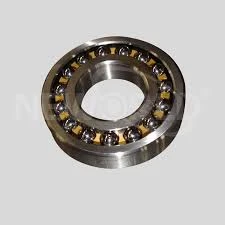
Dec . 03, 2024 18:07 Back to list
6314 c3 bearing dimensions
Understanding the Dimensions and Specifications of 6314 C3 Bearings
In the world of mechanical engineering, bearings play a crucial role in ensuring the smooth operation of machinery. One such bearing type that is widely used in various applications is the 6314 C3 bearing. This article aims to delve into the dimensions, specifications, and applications of the 6314 C3 bearing, providing a comprehensive understanding for engineers and manufacturers alike.
What is a 6314 C3 Bearing?
The designation 6314 C3 refers to a specific type of deep groove ball bearing, characterized by its design and performance attributes. The “63” series is indicative of its type within the wider category of deep groove ball bearings, while the “14” denotes its specific size. The C3 suffix indicates a certain level of internal clearance that allows for greater thermal expansion and higher operational speeds, making the 6314 C3 bearing suitable for various loading conditions and speeds.
Dimensions of the 6314 C3 Bearing
The 6314 C3 bearing has specific dimensions that define its operational capabilities
- Inner Diameter (ID) 70 mm - Outer Diameter (OD) 150 mm - Width (B) 35 mm
These measurements are critical as they determine the bearing's fit within shafts and housings, influencing the overall performance of the machinery in which they are installed. The 6314 C3 bearing typically has a bore (ID) suitable for a shaft of 70 mm, enabling it to secure a substantial load while providing low friction.
Internal Clearance The Importance of C3
6314 c3 bearing dimensions

The “C3” in 6314 C3 signifies a specific internal clearance. Bearings with C3 clearance have a slightly larger internal space than standard bearings, allowing for expanded thermal growth and additional lubrication. This feature is particularly valuable in high-speed applications where the bearing experiences considerable heat. The larger clearance helps prevent the balls from contacting the races during operation, reducing wear and extending the bearing's service life.
Materials and Construction
6314 C3 bearings are typically constructed from high-quality materials, such as chrome steel or stainless steel, ensuring durability and resistance to wear and tear. The quality of the materials affects not only the lifespan of the bearing but also its overall performance characteristics, including load capacity and resistance to corrosion.
Many manufacturers also apply various surface treatments to enhance the bearing's performance under specific conditions. These surface treatments can improve the bearing's resistance to fatigue, corrosion, and wear, enabling it to perform optimally across a range of environments.
Applications of 6314 C3 Bearings
Due to their versatile nature, 6314 C3 bearings are employed in numerous applications across different industries. Common uses include
1. Automotive Industry These bearings are widely used in vehicles, including engines, transmissions, and wheel hubs. 2. Industrial Machinery Found in conveyor systems, pumps, and motors, where smooth and efficient movement is critical. 3. Agricultural Equipment Utilized in machinery like tractors and harvesters that require robust and reliable components. 4. Electric Motors Integral to the functioning of many electric motors due to their ability to handle high speeds and loads.
Conclusion
The 6314 C3 bearing stands out as a crucial component in various mechanical applications due to its specific dimensions, enhanced internal clearance, and robust construction. Understanding these bearings' specifications and performance characteristics enables engineers to make informed decisions when selecting components for machinery. The versatility, resilience, and reliability of the 6314 C3 bearing make it an essential element in modern engineering, contributing to the efficiency and functionality of numerous industrial processes. Proper selection and installation of these bearings can lead to substantial improvements in operational efficiency and maintenance intervals, underscoring the importance of careful consideration during the design and fabrication of mechanical systems.
Latest news
-
Premium Deep Groove Ball Bearings | High Speed & Reliability
NewsAug.29,2025
-
Durable Scaffolding Clamps - Secure & Reliable Tube Connectors
NewsAug.28,2025
-
Common Failures in Thrust Ball Bearings and Solutions
NewsAug.22,2025
-
How Tapered Roller Bearings Can Take Shock Loads
NewsAug.22,2025
-
Angular Bearings in High-Precision Spindles
NewsAug.22,2025
-
The Impact of Misalignment on Cylindrical Roller Bearing Performance
NewsAug.22,2025
